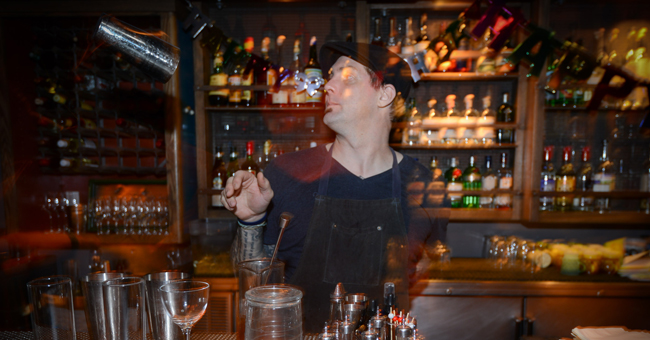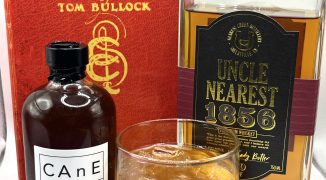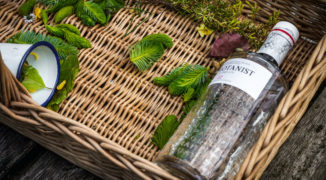No matter which side of the Great Flair Debate you fall on, one thing is true: we’ve come a long, long way since the days of Brian Flanagan. In its more modern form, flair is less about juggling shaker tins or lighting things aflame, and more about creating an unforgettable experience for the guest. Of course, not every bar environment is a fit for flying jiggers or flourished pours. But as more bartenders embrace playfulness, whimsy and fun in their service, some of them are integrating a little bit of low-key flair here and there as just another way to delight their guests.
Anthony Pullen now works as a trade advocacy manager for Bulldog Gin, but he got his start in the competitive flair bartending circuits. “Flair was something that I did for a long time, and it got me to travel the world and see a lot of places,” he says. “Yes, I was one of those juggling guys who traveled and did shows, but it taught me a bunch of transferable skills that can help with guest interaction.” To learn a little more about how Pullen integrates flair into a working bartending routine, we asked him to talk us through his style and demonstrate a few of the tricks he keeps up his sleeve. Read on for his tips for bringing a little theater and showmanship to your bartending style, and watch the full video recap below:
Yes, it can translate to a regular bar setting. So, assuming you don’t work at a T.G.I. Friday’s, how exactly does a shaker tin roll add to one’s overall service? It’s a little bit like driving a car versus training to race in Formula One, says Anthony. “Most of the stuff that happens on a NASCAR or Formula One track doesn’t really apply to driving your car to work, but some of the technology and some of the advancements that are made under those kinds of conditions, and pushing each other to shave fractions of a second off a race time, can translate to regularly driving a car,” he says. “If you look at what flair bartenders do today on stage, yes, it has very little to do with regular service. but everything that they are doing is pushing the boundaries of what is possible in terms of using the instruments you have behind the bar, and elements of that are definitely 100% transferrable to regular service.”
It’s not always about juggling. “Regular service nowadays is becoming more and more demanding as the guest is becoming more and more educated,” says Pullen. “They understand about spirits, they understand about service, they want to experience a good time out. Part of that is flair.” And, he adds, this doesn’t always have to translate as over-the-top tricks. “My personal definition of flair is about creating an experience for the guest — it doesn’t have to be a five minute show. In general, flair should be seen as just part of regular service. It doesn’t have to be trickery, it could be a joke, it could be a level of engagement which people recognize you for. Kind of being remarkable. And it doesn’t necessarily have to involve juggling.”
Having your own tools is essential. Pullen’s biggest tip for mastering flair (in addition to lots of practice)? Get your own tools. “Flair isn’t easy, unfortunately, and it takes a lot of practice, but the biggest tip I can give you is just to use the same tools all the time,” he says. “You’ll get used to the weight of them and how they work. Have those in your hand all the time and the movements will become easier.”
Most of the time, less is more. A little sleight of hand here or there is great, but there’s no need to bust out every possible trick while you’re making a single drink. Pullen recommends breaking flair routines down into smaller movements and limiting yourself to using one or two at a time. “I don’t want to slow down service,” he says.
Practice often, but never on a shift. Perhaps the golden rule of flair bartending? Never, ever practice at work. “It’s the quickest way to get fired, it’s the quickest way to piss off your manager, and it just gives us all a bad name,” says Pullen. Accidents do happen, but you can limit them by only trying out a trick during service once you are completely confident. He recounted a particularly cringe-worthy story involving a bottle of red wine and a guest celebrating her twenty-first birthday. “It wasn’t necessarily a hard trick, but at that point I wasn’t ready to do it at work, and I forced myself to do it,” he says.
And now, a few of Pullen’s go-to moves:
1. The Napkin Drop
“Take your thumb, and put it along the crease [of a standard beverage napkin] so that the crease is away from you, so the first thing that hits the air is the crease, not the open side. One of the things with flair: the throwing part is easy, the catching part is hard. Spin it like a frisbee, it’ll come back to you and rest on the back of the hand. Turn your hand over and just drop it. It means I’m ready to serve you, I’m ready to help you. It’s a very open gesture. Flair is about creating a space where the guest feels you’re engaged and you want to work with them.”
2. The Jigger Tap
“With this one, all you’re going to do is take your jigger on whatever the smallest point is on the top, flip it to the outside of your hand, hit it with basically your finger like a karate chop, onto the big part.”rn
3. The Tin Roll
“You want to find the middle of the tin, and if you want to roll it down any part of your body, the principle is always the same: You’re going to throw it up in the air, you want it to almost stay in the air, you’re going to give it some spin, some momentum. Throw it over the back of your hand with some spin. Once you get a consistent spin so it’s not oscillating in the air, you’ll use that spin to roll it down your arm. Every fiber in your body is going to want to grab this tin once it hits your arm. You have to block that out and just be confident that it’s going to cradle into your left hand. When it comes down your arm, you’ll keep your arm straight, you don’t even need to keep it elevated because it’ll travel really fast and make the catch harder. You can get fancy, catch it behind your back if you feel confident, come up behind your back and down your arm.. it’s a very nice, simple movement.”
4. The Hinge Cut
“This is a two-part move. The first movement is just a simple pour with the bottle at 180 degrees, drop it down to 45 degrees, and you’re adding a little finesse. Hold it on the neck, take it down to 90 degrees, add a finesse. You can also go really long with this as well.”
5. The Stall into Pour
“This is the move that first got me into flair, it brings back memories. It goes toward the guests, so you have to be a little bit careful. Whenever you stall something, there’s a cheeky tip: look at the shoulder of the bottle, don’t look at the top, don’t look at the bottom. When you put it on the back of your hand, you want to look for these three fingers (index, middle, ring) and those knuckles. When the bottle sits on there, essentially it’s sitting between those six points.”
Check out the full video recap of our session with Anthony below, and don’t miss our next livestreamed Shake-Up on July 6.





